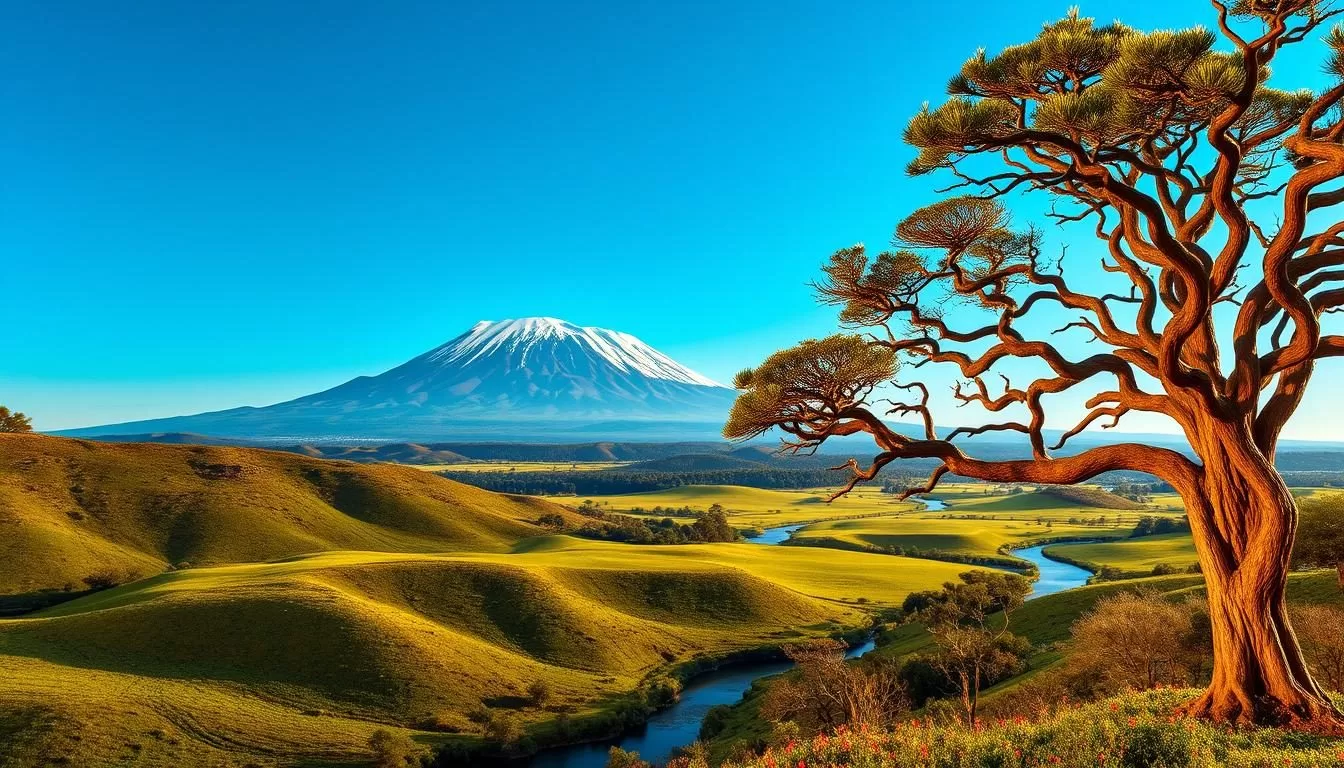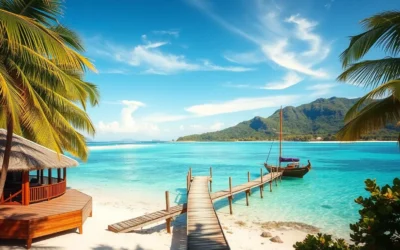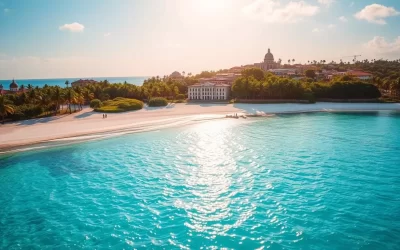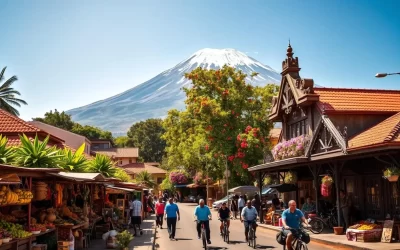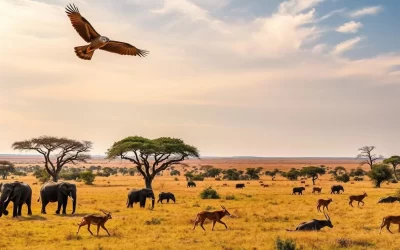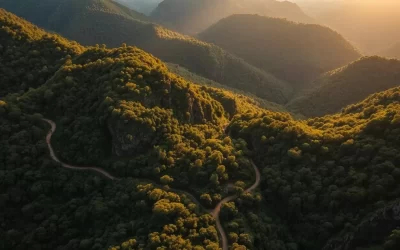Welcome to the ultimate guide to experiencing Mount Kilimanjaro, the highest peak in Africa and the world’s tallest free-standing mountain.
Located in the northern part of Tanzania, near the city of Arusha, this majestic mountain offers a range of exciting activities and breathtaking views.
As you plan your adventure, you’ll find valuable information here to help you choose the right route, prepare properly, and make the most of your time in this magnificent mountain region.
Whether you’re an experienced trekker or a first-time visitor, this guide will ensure your experience is unforgettable.
Discovering Africa’s Highest Peak
As you venture into the heart of Tanzania, you’ll encounter the majestic Mount Kilimanjaro, a wonder that beckons adventurers and nature lovers alike. This iconic mountain is not just a natural marvel but also a significant cultural and ecological landmark.
The Geological Marvel of Mount Kilimanjaro
Mount Kilimanjaro is a geological wonder, standing tall as Africa’s highest peak at 5,895 meters above sea level. Its formation is a result of volcanic activity, with three distinct volcanic cones: Kibo, Mawenzi, and Shira. The mountain’s unique geological features, including its glaciers and volcanic peaks, make it a fascinating subject for study and exploration. The glaciers, although receding, remain an important aspect of the mountain’s ecosystem and a visual spectacle for visitors.
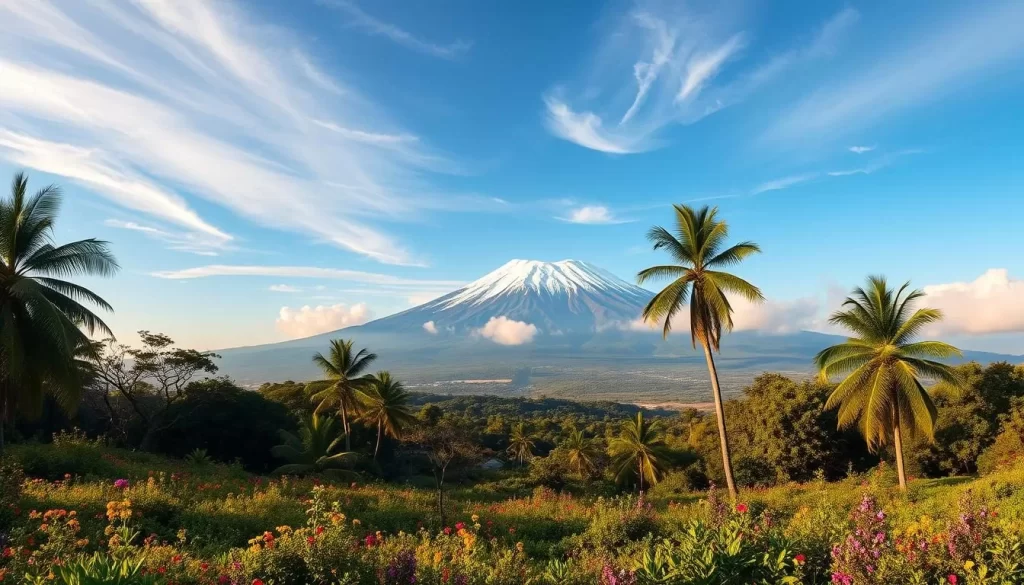
Kilimanjaro National Park: A UNESCO World Heritage Site
Kilimanjaro National Park covers an area of 1,688 square kilometers, encompassing not just the mountain but also the surrounding montane forest belt above 1,820 meters. Established as a game reserve in 1921 and later designated as a forest reserve in 1973, the park was recognized for its ecological importance and natural beauty. It is one of Tanzania’s most visited national parks, ranking third after the Serengeti and Ngorongoro Crater. The park’s diverse ecosystems support a wide range of flora and fauna, making it a UNESCO World Heritage Site since 1987.
The park’s significance extends beyond its natural beauty, as it provides a habitat for numerous endemic species. Visitors to Kilimanjaro National Park can explore the various ecosystems, from rainforests to alpine deserts, each with its unique biodiversity. The park’s status as a national park ensures its protection and preservation for future generations.
Planning Your Visit to Mount Kilimanjaro
As you prepare for your adventure to Africa’s highest peak, understanding the best time to visit and how to get there is crucial.
Best Time to Visit Mount Kilimanjaro
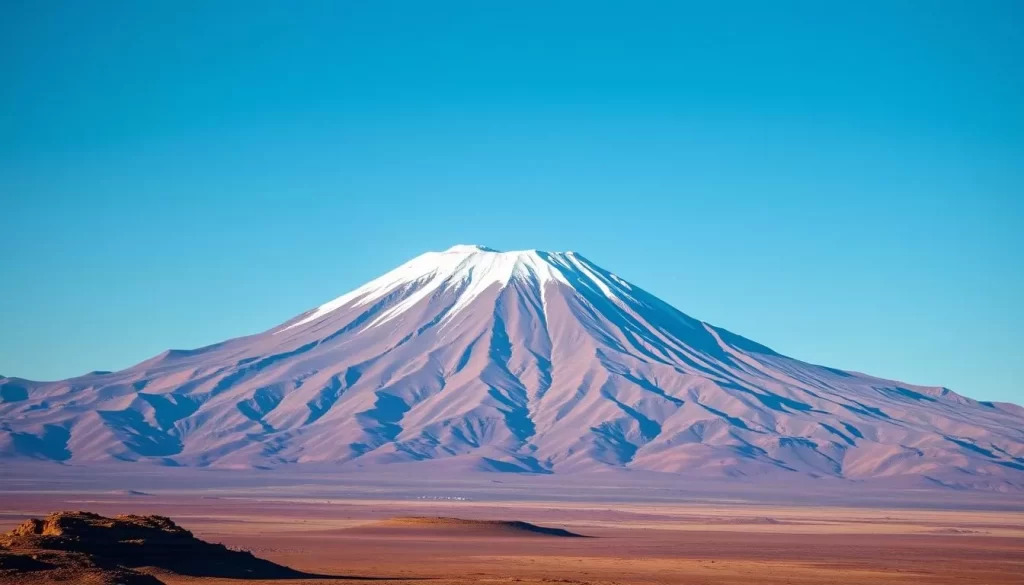
The best time to climb Mount Kilimanjaro is during the dry seasons, which typically occur from January to March and June to October. These periods offer the most favorable conditions for climbing, with clear skies and dry trails, making the ascent safer and more enjoyable.
Climbing during the dry season also enhances your chances of reaching the summit successfully, as the weather conditions are more stable. However, it’s worth noting that these periods are peak season, and you can expect more climbers on the trails.
Getting to Kilimanjaro: Transportation Options
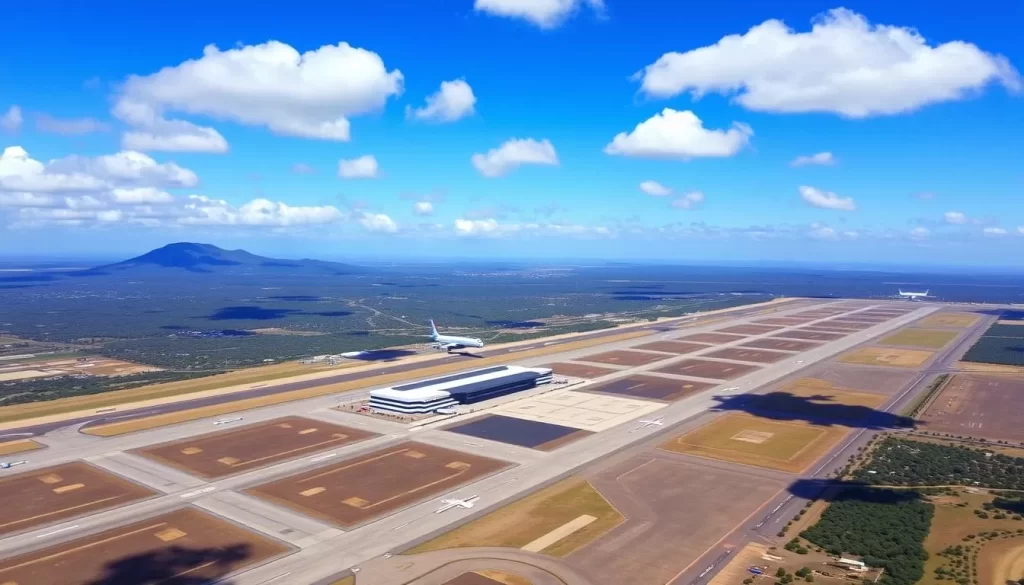
The most convenient way to start your journey to Mount Kilimanjaro is by flying into Kilimanjaro International Airport. This airport serves as the primary gateway to the trailheads for Africa’s highest peak and is also a key access point for nearby safari destinations like Arusha National Park and the Ngorongoro Crater.
From the airport, you’ll need to arrange transportation to Moshi, the main base town for Kilimanjaro expeditions, which is about 40 kilometers away. Your options include pre-arranged transfers, often included in trekking packages, private taxis for a fixed rate of around $50, or shared shuttle buses for approximately $5 per person.
It’s advisable to book your flights well in advance, as Kilimanjaro International Airport is a popular entry point for various safari meccas, leading to high demand for airfare. Many international carriers connect to Kilimanjaro via major hubs like Istanbul, Amsterdam, Doha, Nairobi, and Dar es Salaam, making it relatively accessible for travelers from around the world.
Mount Kilimanjaro, Tanzania: Best Things to Do – Top Picks
Mount Kilimanjaro, Tanzania’s crown jewel, is a treasure trove of thrilling activities and breathtaking landscapes. As you explore this majestic mountain, you’ll discover a wide range of experiences that cater to different interests and fitness levels.
Climbing to Uhuru Peak: The Ultimate Achievement
Reaching the summit of Uhuru Peak is a once-in-a-lifetime experience for many adventurers. The climb is challenging, but the sense of accomplishment and the stunning views from the top make it an unforgettable journey. You’ll traverse through various climates, from tropical rainforests to alpine deserts, as you ascend to the highest point in Africa.
The climb to Uhuru Peak requires careful preparation and physical endurance. It’s essential to choose a reputable tour operator and follow their guidance to ensure a safe and successful climb.
Bird Watching in Kilimanjaro’s Diverse Ecosystems
Kilimanjaro National Park is a haven for bird enthusiasts, with over 130 species recorded within the park. The diverse ecosystems, ranging from rainforests to moorlands, support a wide variety of birdlife. You can spot species such as the Hartlaub’s turaco, white-necked raven, and various sunbirds as you explore the mountain’s different zones.
Bird watching on Kilimanjaro is an enriching experience that allows you to connect with nature and enjoy the park’s biodiversity.
Wildlife Viewing on the Mountain Slopes
Mt Kilimanjaro National Park is home to over 30 animal species, spread across different habitats and vegetation zones. Animal viewing is one of the most common activities in the park, with opportunities to spot both small and big game. You might encounter forest elephants, bushbucks, duikers, and various primates in the lower montane forest zones.
- Explore the various ecological zones, each hosting unique wildlife.
- Enjoy dedicated wildlife viewing excursions with park rangers who know the best locations.
- Keep an eye out for elusive creatures like leopards, hyenas, and buffaloes.
![]()
As you explore Mount Kilimanjaro, you’ll have the chance to experience the rich biodiversity of this incredible region. Whether you’re climbing to the summit or simply enjoying the wildlife, Kilimanjaro offers an unforgettable adventure.
The Seven Routes of Kilimanjaro: Choosing Your Path
Kilimanjaro’s seven routes cater to different preferences and fitness levels, ensuring there’s a path for every adventurer. Whether you’re looking for a challenging climb or a more leisurely ascent, understanding the unique characteristics of each route is crucial for a successful and enjoyable experience.
Machame Route: The “Whiskey Route”
The Machame Route, also known as the “Whiskey Route,” is a popular choice among climbers due to its high success rate and scenic views. This route is considered more challenging but offers a more rewarding experience.
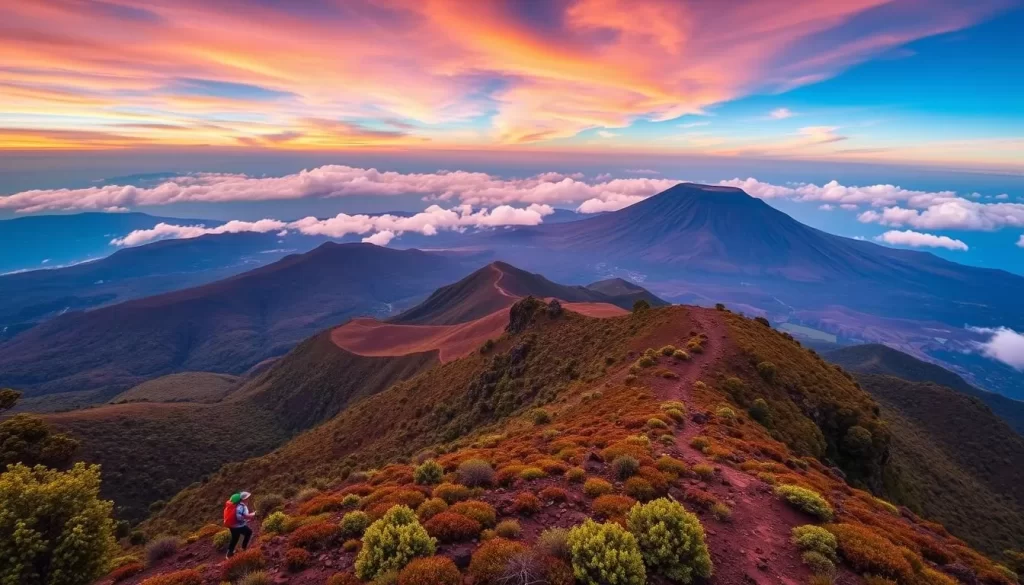
Lemosho Route: The Scenic Choice
The Lemosho Route is known for its scenic beauty and higher success rate due to its gradual ascent, allowing for better acclimatization. This route is ideal for those who want to enjoy the diverse landscapes of Kilimanjaro.
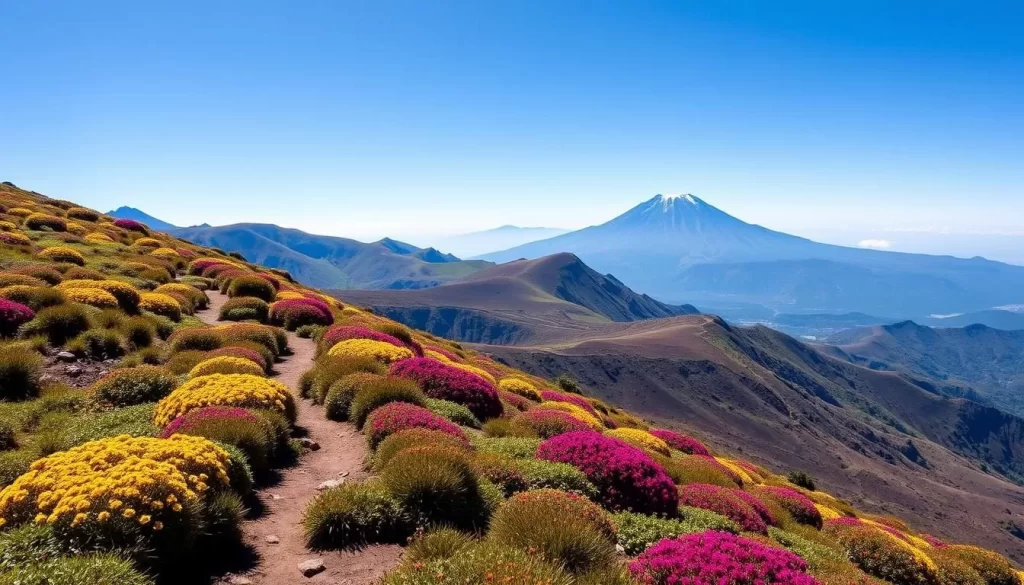
Marangu Route: The “Coca-Cola Route”
The Marangu Route, or the “Coca-Cola Route,” is one of the most straightforward paths to the summit. It’s considered easier because it follows a more direct route, but it’s also less scenic than some of the other options.
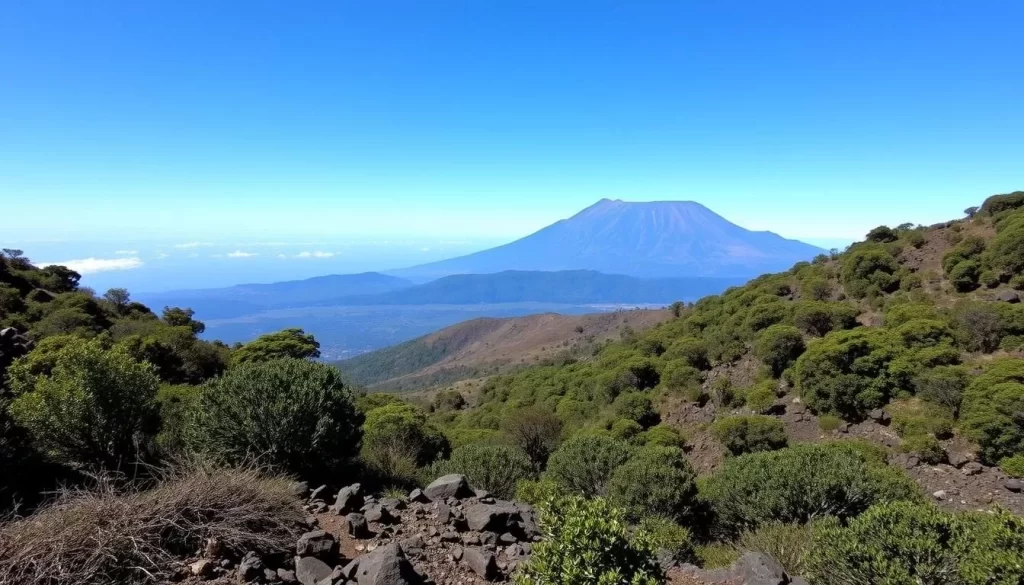
Other Routes: Rongai, Shira, Umbwe, and Northern Circuit
Besides the popular routes, there are other options like Rongai, Shira, Umbwe, and the Northern Circuit, each offering unique experiences.
– The Rongai Route approaches from the north, offering a quieter experience.
– The Shira Route starts at a higher elevation, ideal for those already acclimatized.
– The Umbwe Route is the most challenging, with steep ascents and minimal acclimatization time.
– The Northern Circuit is the longest route, circumnavigating the mountain and maximizing acclimatization.
Choosing the right route depends on your experience, fitness level, and what you’re looking for in your Kilimanjaro adventure. Each route has its advantages and challenges, so it’s essential to research and select the one that best fits your needs.
Preparing for Your Kilimanjaro Climb
To ensure a successful climb, you must be well-prepared for the physical and mental demands of ascending Africa’s highest peak. Climbing Kilimanjaro is a significant adventure that requires careful planning and preparation.
Physical Training and Fitness Requirements
A good level of physical fitness is crucial for climbing Kilimanjaro. You should start training at least 2-3 months prior to your climb, focusing on cardiovascular exercises such as running, cycling, or swimming. Increasing your endurance will help you cope with the demands of high altitude and long hiking days. It’s also essential to incorporate strength training to build muscular endurance, particularly in your legs.
Make sure you’re comfortable hiking for several hours a day with a loaded backpack. You should also acclimate yourself to wearing the hiking boots and gear you’ll use on the mountain.
Essential Gear and Equipment Checklist
Having the right gear is vital for a successful and safe climb. Here’s a checklist of essential items to include in your packing list:
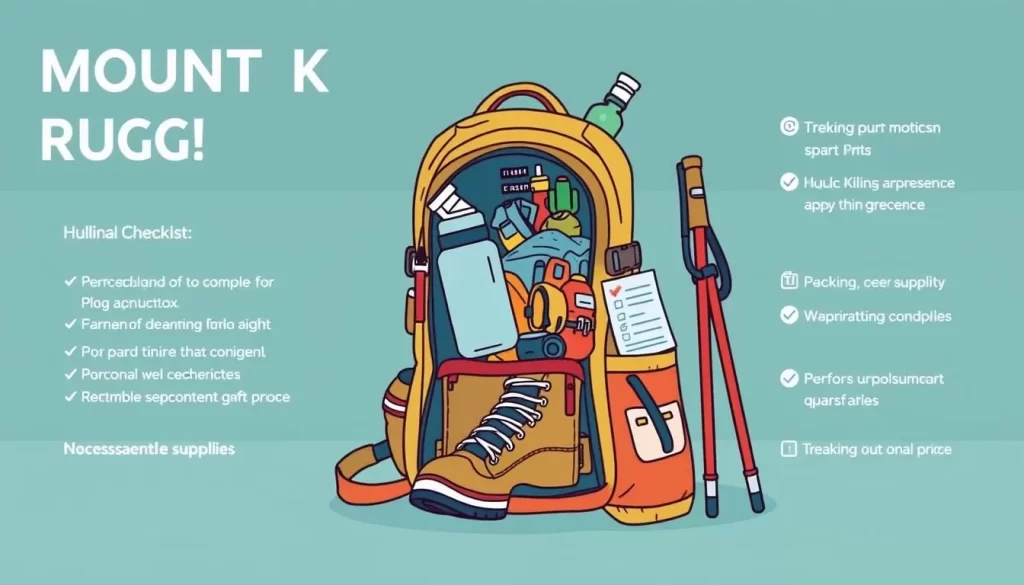
Some of the critical items include sturdy hiking boots, layers of breathable clothing, a waterproof jacket, and a reliable sleeping bag. Don’t forget to pack a first-aid kit, headlamp, and water purification tablets or filter.
Altitude Sickness: Prevention and Management
Altitude sickness is a significant risk when climbing Kilimanjaro. To minimize this risk, it’s essential to understand the symptoms and take preventive measures. Common symptoms include headaches, nausea, dizziness, and fatigue. You can consider consulting your doctor about Diamox (acetazolamide), a medication that can help prevent altitude sickness.
To manage altitude sickness, make sure you’re aware of the symptoms and take rest days as needed. Staying hydrated by drinking plenty of water is also crucial. Your guides will monitor your condition and provide guidance on how to proceed.
A Day-by-Day Itinerary on the Popular Machame Route
Embarking on the Machame Route is an adventure like no other, offering a unique blend of scenic beauty and challenging terrain. This route is one of the most popular paths to Kilimanjaro’s summit, known for its high success rate and diverse landscapes.
Days 1-3: Beginning the Ascent
The initial days of your journey on the Machame Route are crucial for acclimatization. You start your trek from the rainforest, gradually ascending through diverse ecosystems. The first day involves a hike through the lush rainforest, a dense and vibrant environment teeming with life. As you ascend, the landscape changes, and by the third day, you are in the moorland zone, where the scenery becomes more rugged and barren.
During these initial days, it’s essential to pace yourself and stay hydrated. The gradual ascent helps your body adjust to the higher altitudes, reducing the risk of altitude sickness.
Days 4-5: Acclimatization and Scenic Highlights
By the fourth day, you have reached the Barranco Camp, where the scenery becomes even more breathtaking. The Barranco Wall, a towering cliff, is a highlight of this section, offering stunning views and a challenging climb. The night at the Barranco Camp is a great opportunity to rest and prepare for the next day‘s adventure.
On the fifth day, you continue your ascent, passing through the Karanga Valley and eventually reaching the high camp, where you’ll spend the night before the summit push.
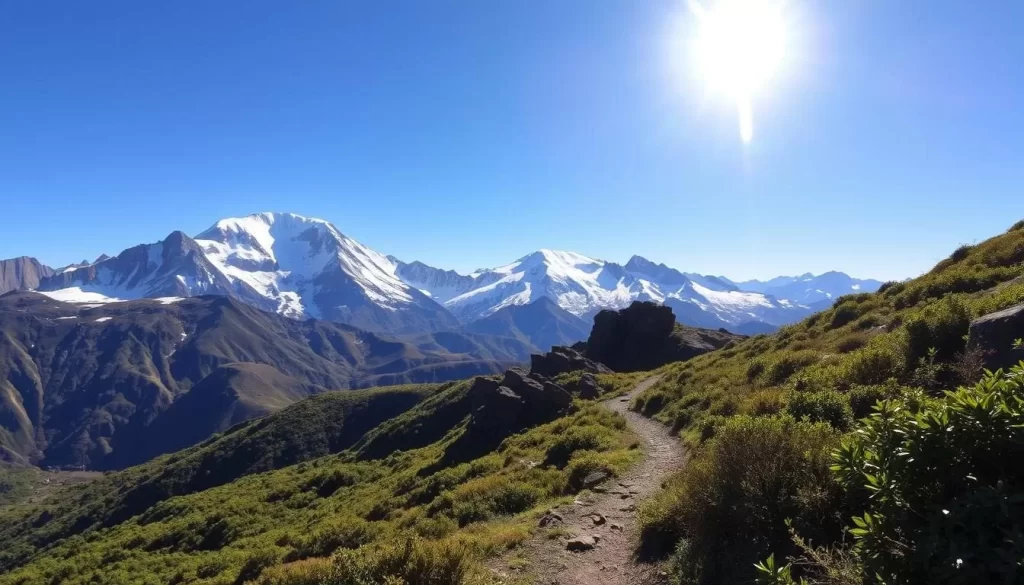
Days 6-8: Summit Push and Descent
The sixth day marks the beginning of your summit push. You start in the darkness of night, climbing steeply up the scree slopes by headlamp. Reaching Stella Point around sunrise is a moment of great achievement, with breathtaking views of the surrounding landscape. From Stella Point, it’s a further push to Uhuru Peak, the highest point on Kilimanjaro, where you can witness an unforgettable sunrise.
After celebrating your success at the summit, you begin your descent, returning to Mweka Camp for the night. The final day involves a descent through the rainforest to Mweka Gate, where you receive your summit certificate.
Accommodation Options on and Around Kilimanjaro
From camping on the mountain to staying in nearby towns, there are numerous options for accommodations near Kilimanjaro. Whether you’re looking for a rustic camping experience or the comforts of a luxury lodge, you’ll find a range of choices to suit your needs.
Camping on the Mountain: What to Expect
Camping is a significant part of the Kilimanjaro experience, with climbers using tents provided by their tour operators. On the mountain, you’ll be camping in basic conditions, with facilities ranging from simple pit toilets to more organized campsites with mess tents and dining facilities.
The camping experience is an integral part of the Kilimanjaro trip, allowing you to immerse yourself in the natural beauty of the mountain. Be prepared for variable weather conditions and basic living arrangements.
Lodging in Moshi and Arusha
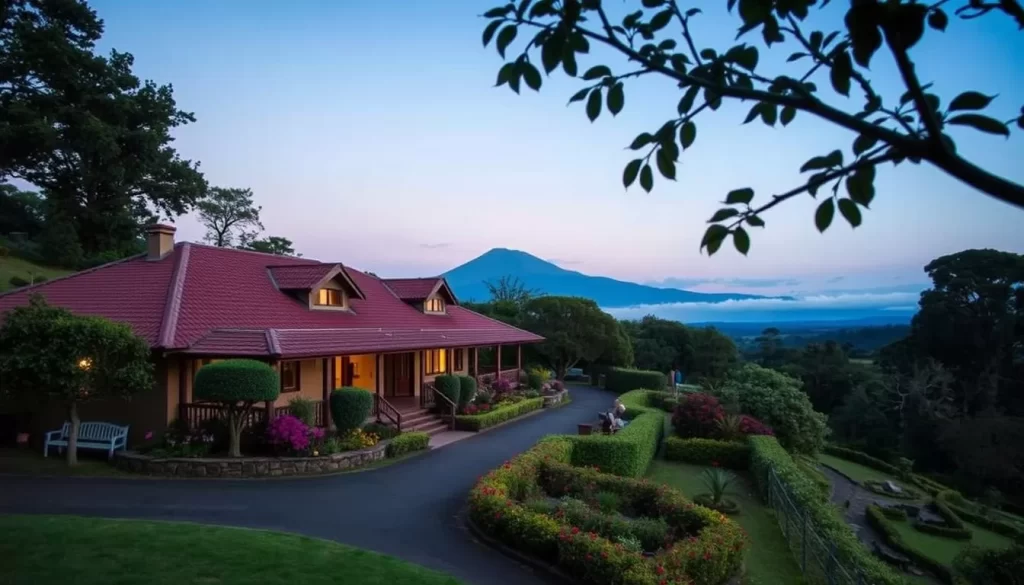
Before and after your climb, you can enjoy more comfort in the towns of Moshi and Arusha. These towns offer a wide range of accommodations, from budget-friendly guesthouses to luxury lodges. Many hotels offer amenities such as hot showers, restaurants, and Wi-Fi, making them ideal for camping trip recovery or pre-climb preparation.
Consider spending at least one night in Moshi before your climb to acclimate to the local environment and attend your pre-climb briefing. After your trip, you might appreciate upgrading to a more luxurious property to relax and unwind.
Cultural Experiences Around Mount Kilimanjaro
As you prepare for your Mount Kilimanjaro adventure, you’ll have the opportunity to immerse yourself in the rich cultural heritage of the region. The area surrounding the mountain is home to numerous villages and communities that offer a glimpse into traditional Tanzanian life.
Visiting Chagga Villages and Coffee Farms
Visiting Chagga villages allows you to experience the local way of life. You can explore the villages, interact with the locals, and learn about their customs and traditions. Many of these villages are also known for their coffee farms, where you can see the process of coffee production from bean to cup. This is a great way to understand the importance of coffee in the local economy and enjoy some of the best coffee Tanzania has to offer. You can expect to be welcomed warmly by the locals, who are eager to share their culture and traditions with visitors.
Local Cuisine and Food Experiences
Your culinary journey on Mount Kilimanjaro is an experience in itself. Your meals on the mountain are carefully planned to provide the necessary energy for your climb. You can expect hearty and nutritious meals designed to sustain you throughout your trek. In towns like Moshi and Arusha, you have the opportunity to sample local cuisine, including dishes like ugali (cornmeal porridge) and nyama choma (grilled meat). Many tour operators also cater to dietary restrictions, ensuring that all climbers have access to suitable food options. You’ll be surprised by the quality of food prepared on the mountain, with many operators employing skilled chefs.
Exploring the Chala Crater Lake
Located near Mount Kilimanjaro, the Chala Crater Lake is a hidden gem waiting to be explored. This serene and picturesque destination offers a unique blend of natural beauty and exciting activities.
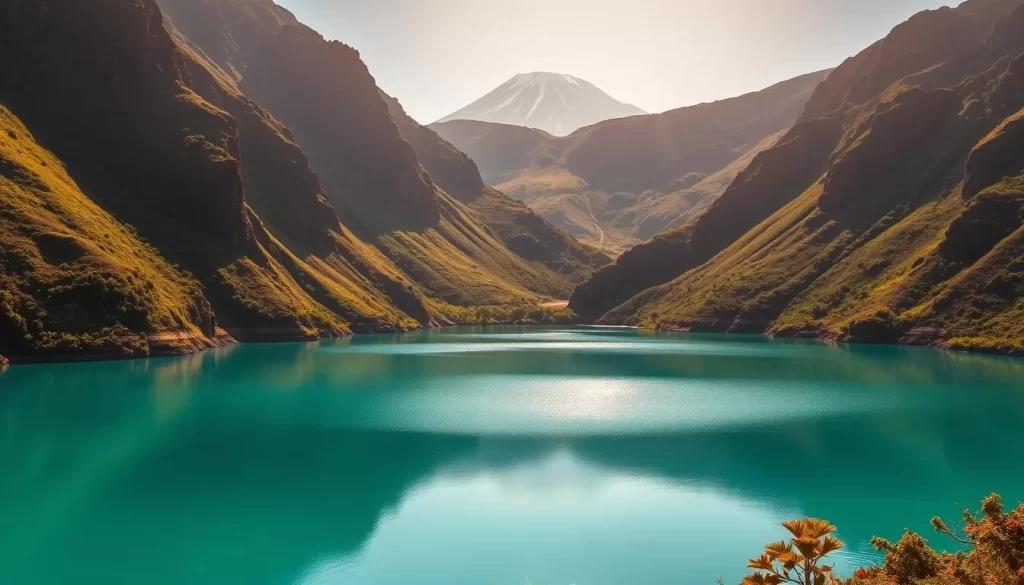
Activities at the Crater Lake
Visitors to the Chala Crater Lake can enjoy a variety of activities that make the most of this stunning location. You can hike around the crater rim, take a dip in the lake’s calm waters, or simply bask in the tranquility of the surroundings.
- Experience the thrill of hiking around the crater rim, offering breathtaking views of the lake and surrounding landscape.
- Enjoy water activities or simply relax on the lake’s shore, taking in the serene atmosphere.
Best Viewpoints and Photography Spots
The Chala Crater Lake offers numerous photography opportunities, with several viewpoints providing stunning vistas. The eastern rim is particularly noteworthy, especially during the early morning when the light is soft and the water is calm.
- Visit during the dry season to benefit from optimal visibility and dramatic contrasts between the lake’s colors and the surrounding landscape.
- Bring a wide-angle lens to capture the expansive crater views, and a zoom lens for wildlife and bird photography.
- The northwestern viewpoint offers excellent perspectives of both the crater lake and Mount Kilimanjaro in the background when weather conditions are clear.
Timing your visit for sunset can reward you with stunning golden light reflecting off the lake’s surface, creating magical photography opportunities. You should plan your activities on Mount Kilimanjaro accordingly to make the most of your time.
Wildlife and Nature in Kilimanjaro National Park
As you explore Kilimanjaro National Park, you’ll discover a rich tapestry of wildlife and natural beauty. The park’s diverse ecosystems, ranging from tropical rainforests to alpine deserts, support a wide variety of flora and fauna.
Flora Zones from Rainforest to Alpine Desert
The Kilimanjaro National Park is characterized by distinct flora zones, each with its unique vegetation. Starting from the base, the rainforest zone is dense with trees and undergrowth, gradually giving way to moorland with heath and shrubs. As you ascend higher, the landscape transitions into the alpine desert, a harsh environment with limited vegetation. This variety of flora zones is a result of the significant climate changes with altitude.
Fauna: From Forest Elephants to Unique Bird Species
The national park is home to over 140 mammal species and 179 bird species, making it a paradise for wildlife enthusiasts. In the lower forest zones, you can spot forest elephants, buffalo, and various primates. The park is also inhabited by smaller residents like tree hyraxes and bushbabies. As you climb higher, the diversity of wildlife decreases, but you can still spot hardy species like the four-striped grass mouse and birds of prey. The national park offers a unique opportunity to observe these species in their natural habitats, making it a memorable experience.
The diverse fauna of Kilimanjaro National Park is a significant part of its appeal, attracting visitors from around the world to this national park in Tanzania.
Expert Tips for a Successful Kilimanjaro Experience
As you prepare to climb Kilimanjaro, understanding the key factors that contribute to a successful summit is essential. A well-planned approach will not only enhance your experience but also increase your chances of reaching the summit.
Hydration and Nutrition on the Mountain
Proper hydration and nutrition are vital when you climb Kilimanjaro. Ensuring you’re well-hydrated and consuming the right foods can significantly impact your performance and overall health on the mountain. It’s recommended to drink at least 3-4 liters of water per day and to eat high-energy foods.
Choosing the Right Guide and Tour Company
Selecting a reputable guide and tour company is crucial for a successful Kilimanjaro experience. Research the best Kilimanjaro tour companies, considering factors such as their experience, safety record, and client reviews. A good tour company will provide experienced guides, a well-planned itinerary, and necessary support staff.
Mental Preparation for the Challenge
Mentally preparing for the climb is just as important as physical preparation. To reach the summit, you’ll need to push through extreme fatigue, cold, and thin air. Practicing positive self-talk, visualization techniques, and breaking the climb into smaller goals can help maintain your motivation and determination.
Your attitude toward discomfort and temporary hardship will significantly impact your experience. Embracing the challenge rather than fighting it makes a tremendous difference. With the right mindset, you’ll be better equipped to handle the challenges that come with climbing Kilimanjaro at your own time.
What to Pack for Your Kilimanjaro Adventure
As you prepare for your Kilimanjaro adventure, understanding what to pack is essential for a comfortable journey. Climbing Kilimanjaro is a significant undertaking, and being well-prepared can make all the difference in your experience.
Clothing Layers for Varying Climates
One of the critical aspects of packing for Kilimanjaro is preparing for the varied climates you’ll encounter. The mountain’s climate ranges from tropical to arctic, so layering your clothing is key. Start with a moisture-wicking base layer, add insulating layers for cold temperatures, and finish with a waterproof outer layer to protect against the elements.
When climbing Kilimanjaro, it’s also essential to consider the night temperatures, which can be quite cold, especially at higher altitudes. Pack warm hats, gloves, and scarves to stay warm.
Personal Items and Medications
In addition to clothing, don’t forget to pack essential personal items and medications. This includes any prescription medications you’re currently taking, as well as altitude sickness prevention medication like Diamox, after consulting your doctor. Other essentials include pain relievers, anti-diarrheal medication, and a personal hygiene kit with biodegradable wet wipes, hand sanitizer, and toilet paper.
For night navigation and pre-dawn summit attempts, a headlamp with extra batteries is crucial. Also, consider packing a water purification method, such as tablets, drops, or a filter, to ensure access to safe drinking water throughout your journey.
| Item | Description | Importance Level |
|---|---|---|
| Moisture-wicking base layer | For temperature regulation | High |
| Insulating layers | For cold temperatures | High |
| Waterproof outer layer | For protection against elements | High |
| Diamox | For altitude sickness prevention | Medium |
| Headlamp | For night navigation | High |
| Water purification tablets/drops/filter | For safe drinking water | High |
Combining Kilimanjaro with Other Tanzania Attractions
With Kilimanjaro under your belt, you’re well-positioned to explore more of Tanzania’s treasures. After your challenging climb, you can extend your trip to experience the country’s diverse landscapes and wildlife.
Safari Extensions in Nearby National Parks
If you’re looking for a thrilling adventure after Kilimanjaro, consider a safari in one of Tanzania’s renowned national parks. The Serengeti and Ngorongoro Conservation Area are must-visit destinations for their incredible wildlife and natural beauty. You can witness the Great Migration, spot the Big Five, and enjoy the breathtaking scenery.
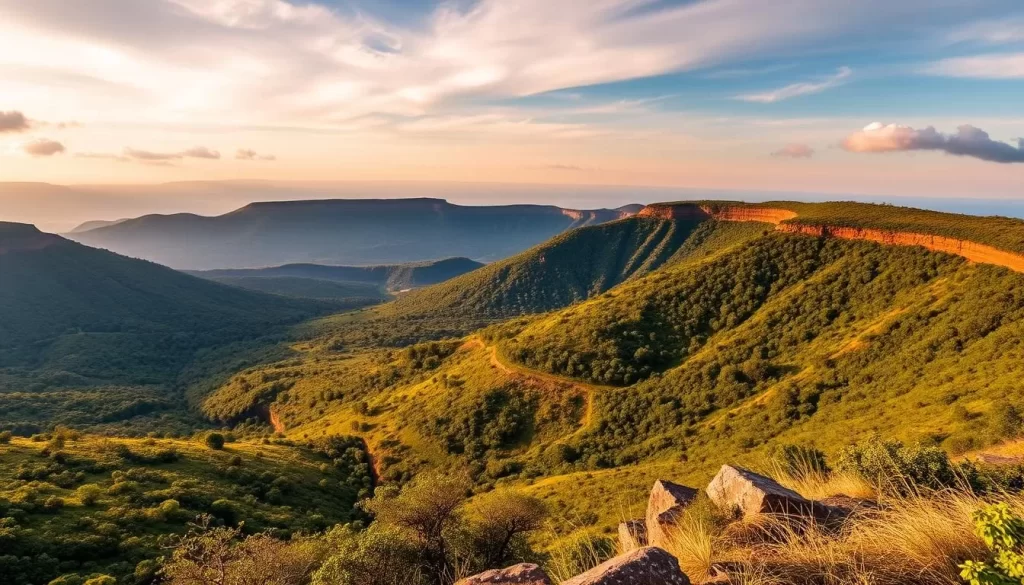
Zanzibar Beach Getaway After Your Climb
After your mountain adventure, unwind on the pristine beaches of Zanzibar. Your journey to this tropical paradise is straightforward, with daily flights from Kilimanjaro International Airport to Zanzibar taking just over an hour. During your time in Zanzibar, you can relax on white sand beaches, explore the historic Stone Town, or enjoy water activities like snorkeling and diving.
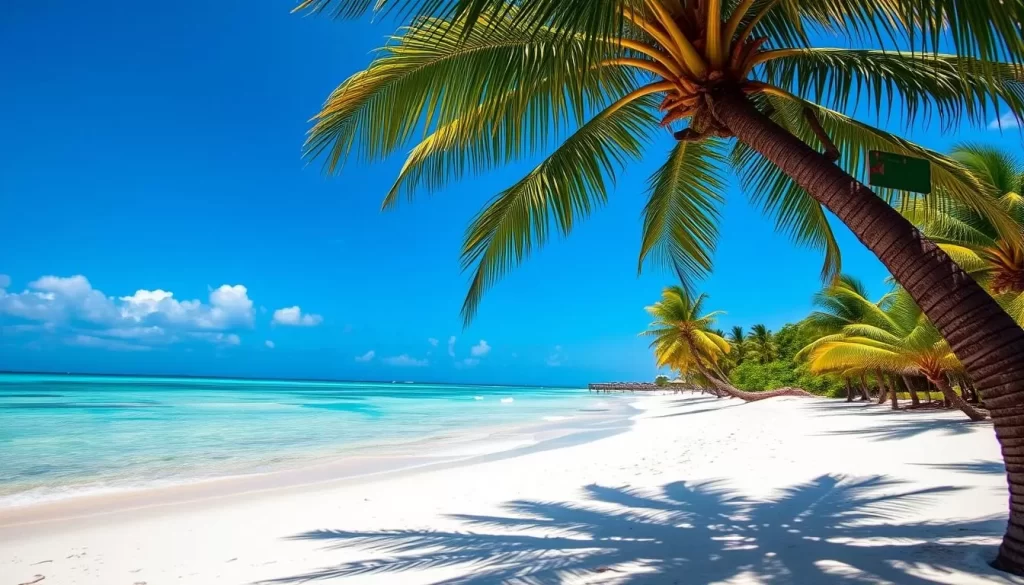
Whether you choose a safari or a beach getaway, you’ll be extending your Tanzanian trip in a memorable way. Both options offer unique experiences that complement your Kilimanjaro adventure.
Safety Considerations for Mount Kilimanjaro
To ensure a safe and successful climb, several factors must be considered when tackling Mount Kilimanjaro. One of the primary concerns is the availability of oxygen; every group on Kilimanjaro should have oxygen bottles with them at all times during the ascent and descent.
When selecting a tour operator, you should prioritize safety by ensuring they carry essential supplies, including oxygen, first aid kits, and communication devices like satellite phones. Your guides should be trained in wilderness first aid and high-altitude medicine, with clear evacuation protocols in place.
- Stay properly hydrated by drinking 4-5 liters of water daily to reduce the risk of altitude sickness.
- Opt for longer itineraries to allow for proper acclimatization, decreasing the likelihood of altitude-related issues.
- Never continue ascending if you experience severe altitude sickness symptoms, as this can lead to life-threatening conditions.
Ensure your travel insurance covers high-altitude trekking (above 4,500 meters) and helicopter evacuation if needed. A well-prepared team and the right precautions can make your climb Kilimanjaro experience both safe and enjoyable.
| Safety Measure | Description | Importance Level |
|---|---|---|
| Oxygen Supply | Carrying oxygen bottles during ascent and descent | High |
| Trained Guides | Guides trained in wilderness first aid and high-altitude medicine | High |
| Hydration | Drinking 4-5 liters of water daily | High |
| Acclimatization | Opting for longer itineraries | High |
| Insurance | Travel insurance covering high-altitude trekking and helicopter evacuation | High |
Conclusion
As you embark on your Kilimanjaro adventure, you’ll discover the beauty of Africa’s highest peak and the rewards of pushing your limits. Climbing Mount Kilimanjaro is a challenging yet rewarding experience that stands at 19,341 feet above sea level. Whether you choose the popular Machame Route or the scenic Lemosho path, your trip to Mount Kilimanjaro will be an adventure of a lifetime. You’ll cherish the memories of camping in tents along the way and the sense of achievement when you reach the summit. When you return home, you’ll carry with you memories that will last a lifetime.
The above is subject to change.
Check back often to TRAVEL.COM for the latest travel tips and deals.
